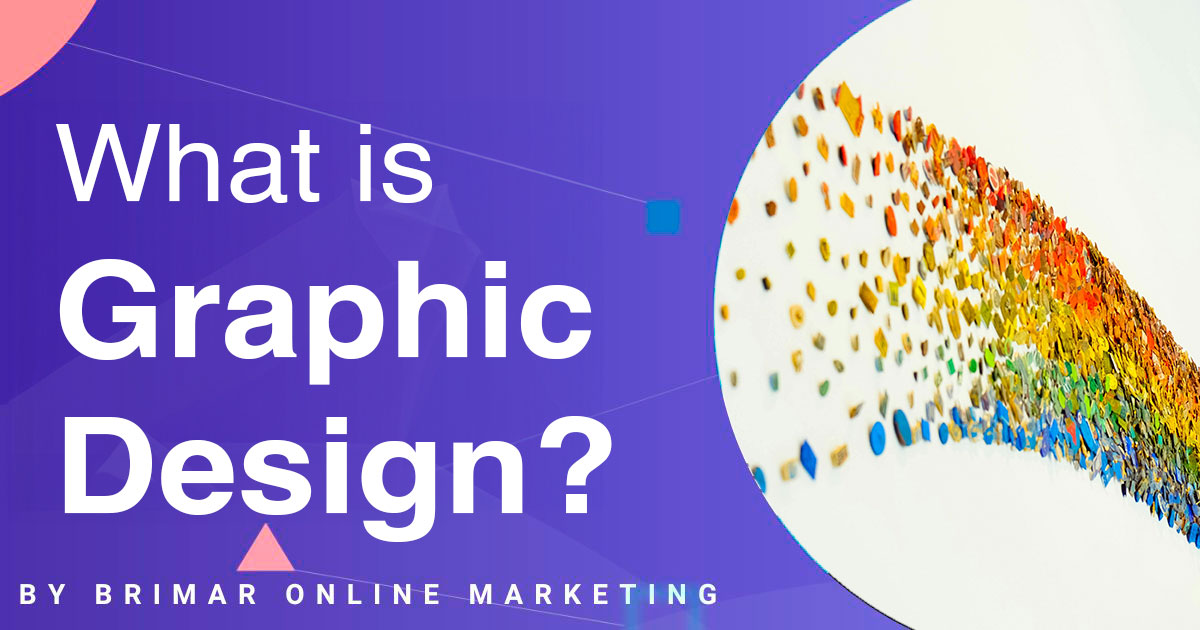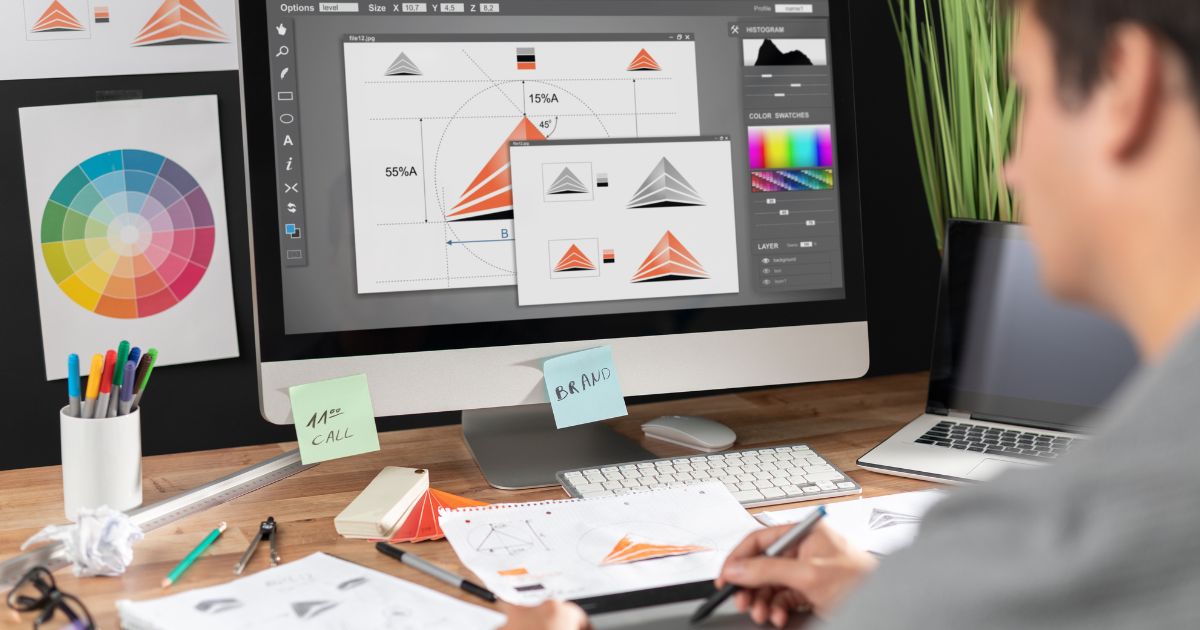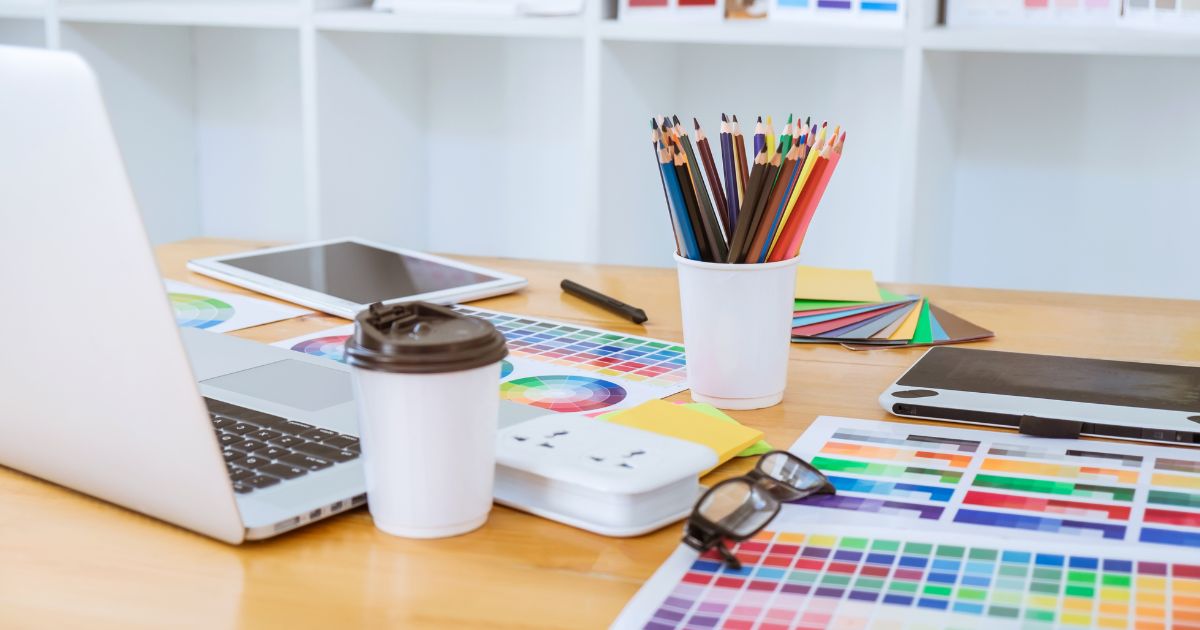
Welcome to the vibrant world of graphic design!
Graphic design is not just a niche field; it’s a ubiquitous presence in our daily lives, subtly shaping our perceptions and interactions with the world around us.
From the logo on your favorite coffee cup to the billboards that catch your eye on your daily commute, graphic design is more than just aesthetics; it’s a powerful tool that influences our choices and experiences.
But what exactly is graphic design, and why is it so important?
In this blog post, we’ll unravel the mysteries of graphic design and shed light on its significance in our modern society.
Whether you’re a budding designer or simply curious about the magic behind the visuals you encounter, join us as we dive deep into the fascinating realm of graphic design.
The Basics of Graphic Design:
At its core, graphic design is the art of visual communication.
It’s about using images, text, colors, and layout to convey messages, ideas, and emotions clearly and compellingly.
Think of it as the language of visuals, where every element serves a purpose in telling a story or delivering a message.
Imagine walking into a bustling bookstore.
The book covers that catch your eye, the signage guiding you to different sections, and even the layout of the shelves—all of these elements are carefully crafted through graphic design to enhance your browsing experience and make information easily accessible.
Graphic design isn’t just about making things look pretty; it’s about making them effective.
Whether it’s a logo for a brand, a poster for an event, or a website for a business, graphic design is the driving force behind capturing attention, evoking emotion, and influencing behavior.
In essence, graphic design is the silent storyteller of our visual landscape, shaping how we perceive the world and leaving a lasting impression on our minds.
Do You Need to Improve Your Brand’s Image?
We can help you create a unique image for your brand. Our graphic design services include logo design, logo cleaning, web banner design, brochure design, and more.
The Principles of Graphic Design
When it comes to creating eye-catching and practical designs, understanding the fundamental principles of graphic design is critical.
These principles serve as guiding lights for designers, helping them craft visually appealing and cohesive compositions.
Let’s take a closer look at some of the most essential principles:
- Balance: Balance is all about achieving equilibrium in a design by distributing elements evenly throughout the composition. Whether it’s symmetrical balance, where elements are mirrored on either side of a central axis, or asymmetrical balance, where different elements are balanced based on their visual weight, finding the right balance ensures harmony and stability in the design.
- Contrast: Contrast adds visual interest and emphasis by juxtaposing different elements against each other. This can be achieved through color, size, shape, or texture variations. By leveraging contrast, designers can draw attention to critical elements and create dynamic visual experiences that capture the viewer’s attention.
- Alignment: Alignment refers to the positioning of elements in relation to each other within a design. Consistent alignment creates a sense of order and organization, making it easier for viewers to navigate and understand the content. Whether aligning text along a grid or images with other visual elements, careful attention to alignment enhances clarity and visual cohesion.
- Hierarchy: Hierarchy establishes the order of importance within a design, guiding viewers’ eyes through the content and highlighting key messages or focal points. Through the use of varying sizes, colors, and placements, designers can create a clear hierarchy that directs attention and communicates information effectively.
- Repetition: Repetition involves consistently using visual elements throughout a design to create unity and reinforce key themes or concepts. Whether it’s repeating colors, shapes, or patterns, repetition helps establish a sense of cohesion and reinforces the overall aesthetic of the design.
By understanding and applying these principles effectively, designers can create visually engaging and cohesive compositions that resonate with their audience.
The Tools of Graphic Design

Having the right tools at your disposal is essential for bringing your creative vision to life.
Here are some standard software tools used by graphic designers
- Adobe Photoshop: Photoshop is a versatile raster graphics editor that allows designers to manipulate and enhance digital images precisely. Photoshop offers a wide range of tools and features for creating stunning visual compositions, from photo editing to digital painting.
- Adobe Illustrator: Illustrator is a vector graphics editor ideal for creating scalable and precise illustrations, logos, icons, and typography. With its powerful drawing tools and ability to create vector artwork, Illustrator is a go-to choice for many designers working on projects that require scalability and versatility.
- Adobe InDesign: InDesign is a desktop publishing software for creating print and digital media layouts. Whether it’s designing brochures, magazines, or ebooks, InDesign provides designers with the tools they need to create professional-looking layouts and typographic designs efficiently.
Each software tool plays a unique role in the graphic design process, allowing designers to bring their ideas to life with precision and creativity.
Whether you’re editing photos in Photoshop, creating illustrations in Illustrator, or laying out designs in InDesign, having a solid understanding of these tools is essential for success in graphic design.
The Importance of Graphic Design
Graphic design is more than just making things look pretty—it’s a powerful tool that shapes how we perceive and interact with the world.
Whether we realize it or not, graphic design plays a pivotal role in almost every aspect of our daily lives, from the products we buy to the websites we visit.
- Branding: One of the most significant areas where graphic design shines is branding. Think about iconic logos like the Nike swoosh or the golden arches of McDonald’s. These designs instantly evoke emotions and associations with their respective brands, showcasing the power of visual identity in building brand recognition and loyalty.
- Marketing: In the crowded marketplace of today, effective marketing is essential for businesses to stand out and connect with their audience. Graphic design is at the heart of compelling marketing materials, from eye-catching advertisements to engaging social media posts. A well-designed marketing campaign can capture attention, communicate a message, and drive action, increasing sales and brand awareness.
- User Experience (UX): In the digital age, user experience is paramount. Websites, apps, and other digital platforms must be intuitive, visually appealing, and easy to navigate to keep users engaged. Graphic design plays a crucial role in crafting user interfaces that are both functional and aesthetically pleasing, enhancing the overall user experience and fostering positive interactions with brands.
- Storytelling: Humans are wired to respond to stories, and graphic design is a powerful storytelling tool. Whether through captivating illustrations, compelling infographics, or immersive multimedia experiences, graphic design helps brands tell their story in a way that resonates with their audience on an emotional level. By weaving together visuals and narrative, graphic designers bring stories to life and create memorable experiences that leave a lasting impression.
Real-World Examples
- Apple: Apple’s minimalist approach to design has become synonymous with elegance and innovation. From the clean lines of its product packaging to the intuitive user interface of its devices, Apple’s design philosophy is evident in every aspect of its brand experience.
- Coca-Cola: Coca-Cola’s iconic logo and timeless branding have made it one of the most recognizable brands in the world. Through consistent use of color, typography, and imagery, Coca-Cola has built a brand identity that transcends cultural and linguistic barriers, connecting with consumers globally.
- Google: Google’s homepage doodles are a prime example of how graphic design can engage and delight users. From celebrating holidays to honoring notable figures, these interactive illustrations add a touch of personality to the Google search experience while showcasing the company’s creativity and innovation.
Career Opportunities in Graphic Design

The field of graphic design offers a diverse range of career paths, each with unique opportunities for creative expression and professional growth.
- Graphic Designer: Graphic designers are visual storytellers who use their creativity and technical skills to communicate messages and ideas through imagery, typography, and layout. They work on various projects, including logos, branding, advertising, and print materials.
- Art Director: Art directors oversee the visual aspects of a project or campaign, ensuring that the creative vision is executed effectively and aligns with the client’s objectives. They collaborate closely with graphic designers, photographers, and other creatives to bring concepts to life.
- UX/UI Designer: User experience (UX) and user interface (UI) designers focus on creating seamless and intuitive digital experiences for users. They conduct research, develop wireframes and prototypes, and collaborate with developers to design user-friendly, visually appealing interfaces that adhere to best practices in usability and accessibility.
- Growing Demand: As businesses continue to recognize the importance of strong visual communication in today’s digital landscape, the demand for skilled graphic designers is rising. From startups to multinational corporations, companies across industries seek talented designers to help them stand out in a competitive market and effectively connect with their target audience.
Whether you’re a recent graduate exploring your options or a seasoned professional looking for new opportunities, graphic design offers endless possibilities for creativity, innovation, and impact.
With the right skills, passion, and dedication, you can carve out a rewarding career in this dynamic and ever-evolving industry.
Tips for Getting Started in Graphic Design

If you’re eager to dive into the exciting world of graphic design, here are some practical tips to kickstart your journey:
- Study Design Fundamentals: Begin by learning the basics of design principles, such as color theory, typography, composition, and visual hierarchy. Understanding these fundamentals will be a solid foundation for your graphic design skills.
- Practice Regularly: Like any skill, graphic design improves with practice. Set aside time each day or week to work on design projects, experiment with different techniques, and refine your skills. Whether you create mock-up posters, design logos, or craft digital illustrations, practice is key to mastering graphic design.
- Seek Feedback: Don’t hesitate to share your work with others and ask for constructive feedback. Whether it’s from experienced designers, mentors, or online communities, feedback can provide valuable insights and help you identify areas for improvement. Embrace feedback as a tool for growth and strive to refine your design skills continuously.
- Recommend Resources, Courses, and Online Communities: As you embark on your graphic design journey, leverage various resources to enhance your learning experience. Consider enrolling in online courses or workshops that cover topics ranging from design fundamentals to advanced techniques. Websites like Udemy, Skillshare, and Coursera offer many courses tailored to graphic design beginners.
Additionally, join online communities and forums where you can connect with fellow aspiring designers, share insights, and seek advice.
Platforms like Behance, Dribbble, and Reddit are excellent spaces to engage with the design community and gain inspiration from others’ work.
Conclusion
We’ve explored the fundamentals of graphic design and provided insights into its elements, principles, and significance in various industries.
From understanding the basics of design to exploring career opportunities, we’ve aimed to demystify the world of graphic design for beginners.
As you embark on your graphic design journey, remember to stay curious, creative, and committed to continuous learning.
Explore different techniques, experiment with new tools, and don’t be afraid to push the boundaries of your creativity.
We encourage you to delve deeper into graphic design, explore new concepts, and hone your skills through practice and exploration.
Whether you pursue graphic design as a hobby or consider it a career path, there’s always room to grow and evolve as a designer.
Thank you for joining Brimar Online Marketing on this exploration of what graphic design truly entails.
We hope this blog post has inspired you to embark on your creative journey and discover graphic design’s endless possibilities.
Happy designing!
Our Graphic Design Services Have Helped Our Clients Increase Their Revenue!
“I highly recommend Brimar if your looking to grow your online business. You will be satisfied with the high level of expertise and high quality of services. It has helped my business grow by leaps and bounds.”
CEO

